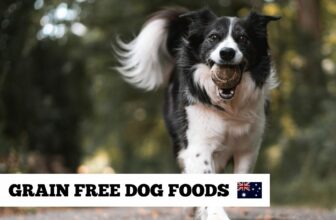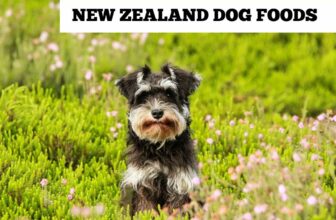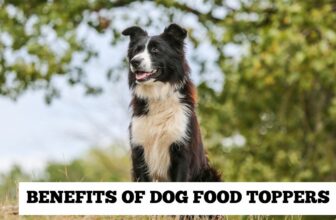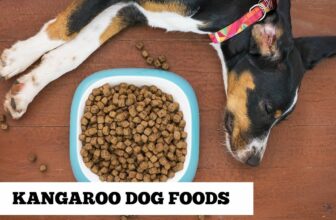
Feeding a hypoallergenic dog food can make a huge difference to your dog’s health whether they have food sensitivities or they don’t. But why?
In this guide you’ll find recommendations of what I consider the best hypoallergenic dog foods in Australia (some are international), but I really want to take this opportunity to help you understand the real issues. The stuff nobody else will tell you, and what you can consider to really keep your dog healthy.
Helping your dog may be simpler than you think.
- What are hypoallergenic dog foods?
- What’s the real deal with hypoallergenic dog foods?
- What are the best hypoallergenic dog foods in Australia?
- Hypoallergenic prescription diets
- AVOID THESE INGREDIENTS in dog foods if your dog has allergies, sensitivities, or intolerances
- Common questions about hypoallergenic dog foods
- What are the benefits of feeding my dog hypoallergenic food?
- How do I know if my dog needs hypoallergenic food?
- Can all dogs eat hypoallergenic food?
- What are the risks of feeding your dog a hypoallergenic dog food?
- How do I choose the best hypoallergenic dog food for my dog?
- Can hypoallergenic dog food cure my dog’s food allergies?
- Can I make my own hypoallergenic dog food at home?
- How do I transition my dog to a hypoallergenic dog food?
- Is hypoallergenic dog food more expensive than regular dog food?
- What is hydrolysed protein in hypoallergenic dog food?
What are hypoallergenic dog foods?
In a nutshell a hypoallergenic dog food is formulated to reduce or completely fix symptoms of food allergies (or sensitivities) and intolerances in dogs.
Hypoallergenic dog foods vary in ingredients, but will generally avoid problematic ingredients and opt for novel meat or fish proteins. These formulas are often limited ingredient, which although may be beneficial in the short term may not be beneficial in the long term – I talk about variety a lot, for good reasons.
What’s the real deal with hypoallergenic dog foods?
What you’re told about hypoallergenic diets
Hypoallergenic dog foods are specially designed (or “scientifically formulated“) to help fix your dog if they’re prone to allergies or have sensitive stomachs.
Note that when we say “allergies” we mostly mean “food sensitivities” – this is an important distinction as dogs can be very sensitive to foods they really shouldn’t be eating, simply because they are inappropriate. And yes, I’m talking about ingredients in many regular dog foods.
Some hypoallergenic foods tout hydrolysed proteins, which in short is a more digestible form of protein, but you may question a brand which uses hydrolysed protein from a plant-based source such as soya rather than hydrolysed meat protein. This may be a red herring.
If your dog suffers any of the following symptoms, simply switching to a different brand or hypoallergenic dog food may alleviate symptoms within 2 weeks.
Signs your dog can benefit from a hypoallergenic dog food:
- Dermatological symptoms:
- Itchiness on any area of the body including skin, ears, lips, face, paws, or eyelids
- Skin rashes and scratching resulting in bald patches
- Ear infections (including chronic ear infections) or yeasty ears
- Runny eyes
- Hives
- Constant licking
- Gastrointestinal symptoms:
- Diarrhea
- Vomiting
- Other symptoms:
- Sneezing
- Poor immunity
All these symptoms are very common in the Australian dog population, and I’ll shortly give you a very good reason why.
Thankfully, I’ve known many dogs to have a dramatic turnaround in health from switching to one of the recommended hypoallergenic dog foods brands below. But before I make those recommendations, lets consider why so many Australian dogs suffer these symptoms.
What it really means: Why do hypoallergenic dog foods really work?
Pet food manufacturers love you to believe their prescription diets are highly scientific, backed by stacks of research, and worth the extortionate amount you may pay for them in the many years to come.
Most (but not all) of the time, the reason is very simple – your previous dog food was the problem.
Ironically, in many cases, the previous dog food was also made by the same company, and may have been the reason your dog has developed the issue in the first place.
Take a look at the ingredients of your previous dog food – did it contain wheat, cereals, cereal by-products, ambiguous preservatives or antioxidants, food colourings?
If so, that’s likely the cause right there.
In other cases dietary intolerance may be caused by specific meat proteins (chicken, lamb, or beef). Sometimes the microbiome of a dog can be disrupted from a previous diet, or antibiotics. Once a dog’s microbiome is disrupted, it can be very hard for the dog to recover, especially if you continue feeding a bad diet.
Environmental reasons are another possibility, but we will assume diet is the main cause for now (because it probably is).
Are hypoallergenic dog foods a miracle cure?
Not really. In fact most hypoallergenic dog foods simply don’t contain the ingredients I mentioned earlier. Instead they use alternatives – different grains, different meats. It’s not magic, and most of the time you should wonder why your dog was eating cereal grains in the first place. Not exactly meat-eater foods, are they?
Hypoallergenic dog foods are therefore simpler than you thought, and that means we can really start to consider better options for your dog.
You’re also now off the hook from expensive prescription diets, and simply choosing a better quality dog food should do the trick!
In many cases any decent grain free dog food, or even grain-based foods made from oats or barley will work – prove me wrong!
Now it’s time for recommendations!
What are the best hypoallergenic dog foods in Australia?
Most of us feed our dogs dry food (i.e. kibble/biscuits). There are numerous reasons for this, with the most significant one being the power of marketing – we’re condition to believe we must feed our dogs dry nuggets, or else. But that really isn’t true, and fundamentally makes little sense.
Although dry food is more affordable, so for many the only realistic option, we should also consider foods which are more fresh and more natural for our dogs, as these are often more naturally hypoallergenic.
We’ll look at decent hypoallergenic dry dog foods shortly, but first lets consider some better options which can make up part of your dog’s diet even if you rely on dry food as well:
Best fresh, raw, or BARF hypoallergenic dog foods
Lyka Pet Food
The fresh pet food brand Lyka offer a Hypoallergenic Pro Goat formula which is specifically tailored to dogs with dietary sensitivities or allergies. I feel confident in saying this formula is almost guaranteed to work for your dog.

Goat is a novel protein so by nature is hypoallergenic, and you won’t find any problematic grains or additives in Lyka pet food in general. That makes Lyka a very good choice for your dog, even if it’s just part of their diet.
As a Pet Food Reviews reader you can receive 30% off your first order of Lyka with this link.
Frontier Pets
Frontier Pets is a wonderful Australian brand of pet food, and an excellent way of feeding your dog a “raw” diet with nigh-on the convenience of kibble.
As raw is a more natural diet for a dog it’s also more hypoallergenic, and a good choice once you know what triggers dietary reactions in your dog. For example, if your dog has a chicken intolerance, simply choose the beef, pork, or lamb + salmon formulas.
Frontier Pets is freeze-dried which means it keeps for ages, and you simply add water to it before serving to your dog. Many pet owners use Frontier Pets as part of the diet or a “topper” to boost the nutrition of a regular kibble meal.
Highly recommended as a solid hypoallergenic choice.
Eureka
Eureka has to be one of my favourite Australian brands of dog food for many reasons – it’s more affordable than other highly recommended dog foods, is nearly “whole prey” in it’s entirety, and as an air-dried food it’s as simple as feeding it straight from the bag (so as convenient as dry food).
Most dogs react to chicken, inappropriate grains, or additives. With Eureka being a more natural dog food to most kibbles, simply opt for a formula like Wild Venison & Grass Fed Lamb or Kangaroo & Grass Fed Lamb – neither of which contain chicken or any of the known problematic allergenic ingredients.
Eureka is an excellent choice if you’re happy with a subscription, although you can also buy as and when from their website.
As a Pet Food Reviews reader you can receive a free Welcome Pack worth $50 with this link (with a 1.8kg minimum prescription).
ZIWI Peak
One last brand I’ll mention is the world famous “whole prey” air-dried food ZIWI Peak.
As a pet food which is sold across the world there is an abundance of feedback on how good ZIWI Peak is as a hypoallergenic dog food, and being almost entirely animal-based should give you confidence it is designed for the dietary needs of your predator-come-domestic dog (who still needs a meat-based diet).
ZIWI Peak has been a long-standing highly-recommended brand, and simply loses out to Eureka above as it’s (1) from New Zealand rather than Australia, and (2) is a much bigger brand – personally I tend to favour smaller brands who rely on quality and consumer feedback more than larger brands do.
Read the full ZIWI Peak dog food review.
Best dry hypoallergenic dog foods
I’ll start with hypoallergenic dry dog foods (biscuits) as these are what most people feed. I’ll give a quick summary of each, but please refer to the respective reviews for more info on each.
Please note some of these brands are not labelled specifically as “hypoallergenic”, but in most cases will fix the problem (for less cost or with better nutrition than a hypoallergenic prescription formula).
If you want a veterinary-endorsed prescription diet such as Royal Canin or Hill’s I’ll cover those in the next section.
Orijen & ACANA
Orijen is one of the most expensive dry dog foods simply because it’s very high quality, being almost “whole-prey” ingredients. No cost-cutting. ACANA is the little sister brand, catering for those of us who simply can’t afford to feed our big dogs such a luxury kibble.
Both brands have excellent feedback from dog owners worldwide. Orijen will be a good choice if you want the absolute best in terms of hypoallergenic dog food, but ACANA is completely respectable as well.
Related: Orijen dog food review | ACANA dog food review
Open Farm
Open Farm, like Orijen and ACANA above, is another top quality dog food from Canada. It’s much cheaper than Orijen, and even ACANA, but it’s still a very good choice and won’t suit you if you’re not made of money.
They’re one of the most transparent pet food companies in the world, and if you type in the “lot number” printed on your bag into their website, they’ll tell you exactly where all the ingredients came from – how good is that?
Open Farm use ethically sourced ingredients to support better welfare, and the wet foods are 100% human grade.
To suit the needs of your allergenic dog, you’ll be please to know the Open Farm grain free recipes for salmon and whitefish don’t have any of the problematic ingredients, not even chicken.
Related: Open Farm dog food review
Taste of the Wild & Canidae
If you can’t afford the price tag of Orijen or ACANA, the next best are Taste of the Wild and Canidae. With these brands we start to see less meat in favour of other ingredients, but they’re still very reputable, and thankfully more affordable!
Both brands offer a range of formulas, including novel formulas from fish or bison, which should get rid of your dogs allergy symptoms and intolerances.
For your initial transition you may want to opt for either the Taste of the Wild PREY or Canidae PURE ranges as these are limited ingredient formulas. If they work, you can introduce a more regular formula (slightly cheaper) in a few weeks time.
Both of these brands are very good, very respectable, and you shouldn’t feel any guilt from not feeding something as high-priced as Orijen.
Related: Taste of the Wild PREY dog food review | Canidae PURE dog food review
Petzyo
Petzyo have proven themselves as an Australian pet food company, and I’ve found their dry dog food to be a really high quality. Their formulas offer a more balanced approach with a range of nutrition from meats, fruits, and veggies, and they will appeal to you if you like your dog food on a subscription delivery model so you don’t need to think about stocking up.
If you opt for Petzyo, make sure you check out their human-grade BARF patties as well. Great hypoallergenic nutrition boosters your dog will love!
Related: Petzyo dog food review (including a money off coupon!)
LifeWise
Over the years I’ve found LifeWise to work extremely well as a hypoallergenic dog food. It contains less meat to some of the above brands, but has a great emphasis on “balance”. I consider LifeWise one of the most reputable Australian dog food brands, and the feedback from Aussie dog owners over the years really shows the quality of this dog food.
LifeWise are one of the only Australian pet food companies to offer formulas that cater for health conditions in the way prescription diets do, including hypoallergenic dog foods.
Related: LifeWise dog food review
More dry food options…
When you realise hypoallergenic diets are little more than those which avoid ingredients like cereal-grains (which aren’t really appropriate for a dog anyway), you start to realise how many options you have.
However, most of the time you’ll want to avoid chicken, beef, or lamb as well. Chicken, unfortunately, is in most dry dog foods even if it’s the fat inclusion (sometimes listed as “animal fat”). See the section below on ingredients to avoid, but for now here’s a list of other hypoallergenic dog foods in Australia:
- Black Hawk – A range of formulas both grain and grain-free. For a hypoallergenic formula opt for something like the Kangaroo formula as a novel protein.
- Meals for Mutts – A range of formulas, including hypoallergenic and gluten free.
- Ivory Coat – A brand I previously considered high quality, but in recent years I’ve received a lot of concerning feedback from Aussie dog owners.
- Royal Canin – Discussed next.
- Hill’s Science Diet / Prescription Diet – Discussed next.
Hypoallergenic prescription diets
Most Australian vets will recommend one of two brands if they believe your dog is allergenic. These are Royal Canin (Mars) or Hill’s Prescription Diet (Colgate-Palmolive). Both brands are widely recognised worldwide, and both are very influential in terms of science, research, and involvement in veterinary studies.
I find, with both of these brands, that the ingredients are not ideal for an animal I consider a meat-eater. You may find this too when you read the ingredients.
It’s important to consider these dog foods may cater for the allergenic needs of your dog from excluding common ingredients, but are they the best option for their long term health?
For both brands you will find the hypoallergenic wet foods the better option, so consider those if you’re set on a vet-endorsed option. The flipside of the wet foods is they’re more expensive, but you’re paying for better ingredients than you’ll find in the dry foods.
Royal Canin Hypoallergenic (Veterinary Diet)
What many people fail to realise is Royal Canin is a Mars product. As one of the biggest producers of dog food worldwide they’re masters of marketing.
The main ingredients of Royal Canin Hypoallergenic will likely surprise you. Especially if you consider your dog a meat-eater.
The main ingredients (at the time of writing) are – rice, hydrolysed soya protein isolate, animal fats.
Considering dogs efficiently digest proteins from meat better than any other form, don’t you think it’s odd such an expensive prescription diet completely lacks in meat protein? Instead favouring soya?
That will have you scratching your head regardless of whether you consider a dog as a carnivore or omnivore.
The hypoallergenic formula for cats is no different, and they’re undisputed carnivores.
Related: Royal Canin hypoallergenic dog food review.
Hill’s Science Diet / Prescription Diet
The Hill’s offering for “Skin/Food Sensitivities” is the z/d Canine formula. According to the Hill’s website this is “U.S. VETERARIANS #1 RECOMMENDED” according to CM Research 2021. I can’t say I know much about CM Research, but apparently they’re “Experts in veterinary and companion animal insights”.
Reminds me of “Authorised” car dealers. Authorised by whom? Great Aunt Nelly?
For Hill’s Prescription Diet z/d, endorsed by Australian vets, you’ll be feeding your meat-loving pooch the following – corn starch, hydrolyzed chicken liver, powdered cellulose, soybean oil.
Credit where credit’s due I like the chicken liver part. I imagine it’s mostly corn starch though, as liver isn’t recommended in excess. Otherwise you may be wondering if your dog’s a vegan.
Related: Hill’s Science Diet dog food review | Hill’s Prescription Diet dog food review
AVOID THESE INGREDIENTS in dog foods if your dog has allergies, sensitivities, or intolerances
If your dog is displaying signs of food sensitivities or intolerance then your most valuable consideration is what is causing it. Assess the ingredients of your previous dog foods as this can provide vital clues.
Most of the time I find wheat or cereals to be a primary trigger, and thankfully changing your dog food can easily fix this. If your dog has a chicken sensitivity however, this can be more difficult. Most dog foods in Australia contain chicken, even if it’s not mentioned in the formula name.
Avoid the following ingredients in a dry dog food if your dog is showing signs of food sensitivities:
- Wheat
- Cereals or Cereal By-Products (may contain wheat gluten)
- Ambiguous preservatives or antioxidants – Listed as “Preservatives” or “Antioxidants” without any clarification to what has been used.
- Food colorings.
- Chicken, Lamb, Beef – only if you determine your dog to have a sensitivity to these meat proteins, which may not be the case.
- Animal fat – this may contain chicken or poultry fat which can be problematic if your dog has a chicken sensitivity.
Common questions about hypoallergenic dog foods
What are the benefits of feeding my dog hypoallergenic food?
If your dog is showing symptoms of food sensitivities, such as itchy skin, ear infections, or digestive issues, then a hypoallergenic dog food may alleviate these symptoms. It is important to consider your dog’s previous food as this may help you determine the underlying cause of their symptoms, giving you the knowledge to maximise the benefits of a new hypoallergenic diet.
How do I know if my dog needs hypoallergenic food?
Dietary sensitivities cause a range of symptoms including poor skin and coat, itchiness, flatulence, and sometimes diarrhea and vomiting. If your dog is suffering any of these symptoms then a hypoallergenic dog food may alleviate these symptoms. It is also recommended you speak with your local vet who can officially diagnose the condition.
Can all dogs eat hypoallergenic food?
Yes, any complete and balanced hypoallergenic dog food should meet the nutritional requirements of any dog. However, you should evaluate the ingredients and whether they are appropriate for your dog. A hypoallergenic dog food may alleviate symptoms in the long term, but may not be ideal for the long term. Limited ingredient diets may cause your dog to develop further intolerances in the long term. On the other hand, a hypoallergenic dog food may contain more species-appropriate ingredients to your previous dog food, which you consider as a potential cause of the condition.
What are the risks of feeding your dog a hypoallergenic dog food?
Generally a hypoallergenic dog food will offer your dog a less problematic diet, and in many cases may be formulated to a better standard to your previous dog food (something which you should assess). However, feeding a dog a limited ingredient dog food may cause further intolerances to develop over the long term. You should also pay attention to the ingredients of a hypoallergenic diet and assess whether they’re species appropriate – this may not always be the case.
How do I choose the best hypoallergenic dog food for my dog?
Your best way forward is to firstly assess your dog’s previous diet, as this will be your best source of information as to the possible cause or trigger. Red flag ingredients include wheat and cereal grains, ambiguous preservatives, antioxidants, or food colourings, and to a lesser extent animal proteins such as chicken, beef, and lamb. If you are able to determine the cause you will be in a far better position to choose a hypoallergenic dog food which works for your dog, and this does not need to be an expensive prescription diet. In many cases, any dog food without those red flag ingredients may work.
Can hypoallergenic dog food cure my dog’s food allergies?
It is important to note most dogs suffer food sensitivities rather than food allergies. Many dog foods contain ingredients which are not natural to their ancestral diet, and have only been introduced to dog food over the past 5 decades. Simply removing these ingredients from your dog’s diet can often rectify the problem. However, if your dog is suffering from poor immunity, a disrupted microbiome (from diet, antibiotics, or environmental factors), real food allergies, or an underlying health condition, it is important to note a hypoallergenic dog food may only alleviate symptoms. Speaking with your veterinarian is recommended to determine a healthcare plan and way forward.
Can I make my own hypoallergenic dog food at home?
Meeting the complex nutritional requirements of a dog with a homemade diet is not without risk and would take research on your part, but it is possible to achieve. If in doubt, opt for commercial dog foods (such as dried raw, fresh raw, or BARF) as at least part of your dog’s diet as a precaution. Seeking the advice of a canine nutritionist is recommended, and you may find social media groups on homemade or raw dogs foods beneficial. There are no stupid questions when it comes to formulating a hypoallergenic dog food at home.
How do I transition my dog to a hypoallergenic dog food?
Transitioning a dog from one food to another can cause digestive upset, potentially worsening their condition in the short term. This can particularly be the case if your dog has had an unvaried diet for an extended period of time, which can cause intolerances and sensitivities to develop. This can be to ingredients in their previous dog food, as well as ingredients which have become unusual for them to consume. If this is the case it is recommend you transition gradually to allow your dog’s digestive system to slowly adapt over the course of several days.
Is hypoallergenic dog food more expensive than regular dog food?
Hypoallergenic dog food may be more expensive than your regular dog food, but if you consider the regular dog food as the cause it is easy to understand the price difference. Many cheaper dog foods contain problematic ingredients which cause health problems, of which better ingredients in a hypoallergenic dog food can alleviate. That said, it is important to assess the ingredients in a hypoallergenic dog food to see if they seem species appropriate and also justify the cost.
What is hydrolysed protein in hypoallergenic dog food?
Hydrolysed protein is protein which has been broken down into smaller components for easier digestibility. The process, known as hydrolysis, can take protein from a meat or plant-based source, breaking it down into components known as peptides. The process is typically done with enzymes. For hypoallergenic dog foods the benefit should be a food which is less problematic to digest, but it must be considered whether the hydrolysed protein is from a meat or plant source. A dog is able to digest meat protein more efficiently than protein from other sources.






Meals for Mutts (turkey) claims to be hypoallergenic but made my dogs sick. I believe (through a process of elimination) that my dogs are allergic to chicken so this food may contain chicken in some form (undisclosed on packaging).
FYI, Orijen and Acana is also owned by Mars